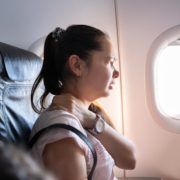4 Spine-saving tips for less pain during Holiday Travel
For many, Holidays mean traveling to visit family and friends. Or perhaps you’re a New England resident and just want to get away from the cold for a few days. Either way, hours in the car, hours on a plane, and sleeping on mattresses you’re not used to can wreak havoc on your spine.
The good news is there are some simple and easy things you can do to help prevent this. Here are 5 of my top tips to save your spine during holiday travel:
Tip #1: Interrupt your sitting
The biggest strain on your body while traveling is undoubtedly the prolonged periods of sitting. Our bodies are made to move continuously throughout the day. Too much sitting puts extra load and compression on your spine, and can trigger an underlying problem you weren’t even aware of. On road trips or long plane rides, getting out of your seat is critical for keeping your neck and back healthy. In a car, plan extra time in your trip to pull over at rest stops and walk around. On a plane, choose an aisle seat so it’s easy to get up and stretch. I recommend interrupting your sitting every 30 min for good neck and back health whenever you’re able. Keeping up with that frequency while traveling can be difficult, but something is better than nothing.
Tip #2: Use a lumbar pillow
While sitting, a proper lumbar pillow is not only essential for good lower back alignment, but also for proper neck alignment. We have natural curves in our spine that are designed to absorb shock and disperse load. Ever heard of the dreaded “forward head”? That’s the posture your neck assumes when it needs to compensate for lower back slouching. When your spinal curves are not maintained, such as when sitting or slouching for prolonged periods, you get abnormal and unwanted forces throughout your spine, resulting in pain and stiffness that can occur in both your neck and lower back. When purchasing or making your own lumbar pillow – you want to make sure the roll is thick enough to maintain the natural curve (lordosis) in your lower back without much effort while you sit. The built-in lumbar supports that you can adjust in your car are typically not adequate enough – so don’t rely on those. Have a small pillow or roll handy to compensate.
Tip #3: Maintain a neutral spine while you sleep
When traveling and facing various mattresses that might not align with your typical sleeping setup, there are ways to compensate to prevent neck and back pain. Start by packing a portable travel pillow that offers adequate support for your neck’s natural curve. If the mattress is too firm, consider using extra blankets or folded clothes strategically placed under specific body parts, like your hips or shoulders, to create a more cushioned surface. If the mattress is too soft, try placing a firm object, like a folded towel or a small pillow, beneath your lower back for added support. Sleeping on mattresses you’re not accustomed to while traveling can be challenging – and you’re never quite sure what you’ll be getting into. The name of the game is to position yourself in a way so that you’re sleeping in a neutral position – where your head, neck, and spine all align.. It might take a bit of trial and error, but adapting your sleeping setup while traveling can significantly reduce discomfort and ensure less pain and strain in your neck and back.
Tip #4: Stay Hydrated
Staying hydrated during holiday travel plays a crucial role in preventing neck and back pain due to its impact on overall bodily function. Adequate hydration supports the elasticity of spinal discs, which act as cushions between vertebrae, preventing them from becoming stiff and compressed. Dehydration can exacerbate muscle tension and reduce flexibility, increasing the likelihood of discomfort and stiffness in the neck and back. By drinking enough water, you help maintain proper circulation, delivering essential nutrients to muscles and tissues, promoting their relaxation, and reducing the risk of cramping or spasms that often contribute to neck and back pain during long journeys. Plus – hydration supports your body’s ability to recover and repair – so when you’ve got those travel-related strains on your spine that are ultimately inevitable no matter how careful you are – you’ll simply feel better faster.
Traveling any time of year, especially during the Holidays, comes with its own set of challenges and problems. There is no need to add unwanted neck and back pain to that list. Implementing even just one of these spine-saving tips next time you travel can make a real difference in alleviating neck and back pain – and allow you to focus on your destination instead.
Are you local to Portsmouth, NH and looking for help?
Request a free discovery visit by clicking here. We will ask you all about what’s been going on and see if we would be the best fit to help you 🙂
Dr. Carrie Jose, Physical Therapist and Pilates expert, owns CJ Physical Therapy & Pilates in Portsmouth and writes for Seacoast Media Group. To request a free copy of her guide to back pain CLICK HERE or to get in touch, email her at [email protected]



